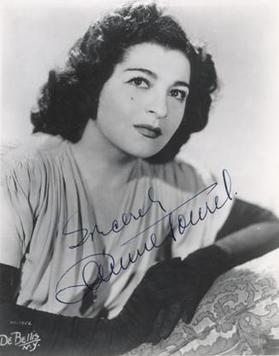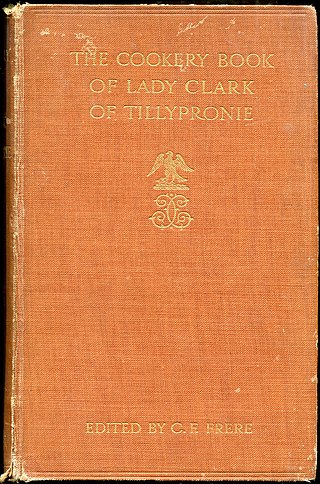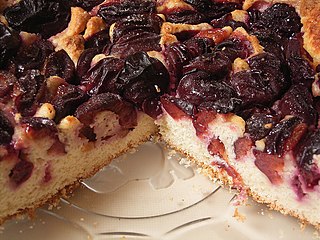
English cuisine encompasses the cooking styles, traditions and recipes associated with England. It has distinctive attributes of its own, but is also very similar to wider British cuisine, partly historically and partly due to the import of ingredients and ideas from the Americas, China, and India during the time of the British Empire and as a result of post-war immigration.

Shepherd's pie, cottage pie, or in its French version hachis Parmentier, is a savoury dish of cooked minced meat topped with mashed potato and baked, formerly also called Sanders or Saunders. The meat used may be either previously cooked or freshly minced. The usual meats are beef or lamb. The two English terms have been used interchangeably since they came into use in the late 18th and early 19th centuries, although some writers insist that a shepherd's pie should contain lamb or mutton, and a cottage pie, beef.

A cookbook or cookery book is a kitchen reference containing recipes.

A profiterole, cream puff (US), or chou à la crème is a filled French choux pastry ball with a typically sweet and moist filling of whipped cream, custard, pastry cream, or ice cream. The puffs may be decorated or left plain or garnished with chocolate sauce, caramel, or a dusting of powdered sugar. Savory profiterole are also made, filled with pureed meats, cheese, and so on. These were formerly common garnishes for soups.

Gastronomy is the study of the relationship between food and culture, the art of preparing and serving rich or delicate and appetizing food, the cooking styles of particular regions, and the science of good eating. One who is well versed in gastronomy is called a gastronome, while a gastronomist is one who unites theory and practice in the study of gastronomy. Practical gastronomy is associated with the practice and study of the preparation, production, and service of the various foods and beverages, from countries around the world. Theoretical gastronomy supports practical gastronomy. It is related with a system and process approach, focused on recipes, techniques and cookery books. Food gastronomy is connected with food and beverages and their genesis. Technical gastronomy underpins practical gastronomy, introducing a rigorous approach to evaluation of gastronomic topics.

Jane Grigson was an English cookery writer. In the latter part of the 20th century she was the author of the food column for The Observer and wrote numerous books about European cuisines and traditional British dishes. Her work proved influential in promoting British food.

French onion soup is a soup of onions, gently fried and then cooked in meat stock or water, usually served gratinéed with croutons or a larger piece of bread covered with cheese floating on top. Onion soups were known in France since medieval times, but the version now familiar dates from the mid-19th century.

Eliza Acton was an English food writer and poet who produced one of Britain's first cookery books aimed at the domestic reader, Modern Cookery for Private Families. The book introduced the now-universal practice of listing ingredients and giving suggested cooking times for each recipe. It included the first recipes in English for Brussels sprouts and for spaghetti. It also contains the first recipe for what Acton called "Christmas pudding"; the dish was normally called plum pudding, recipes for which had appeared previously, although Acton was the first to put the name and recipe together.

The Art of Cookery Made Plain and Easy is a cookbook by Hannah Glasse (1708–1770), first published in 1747. It was a bestseller for a century after its first publication, dominating the English-speaking market and making Glasse one of the most famous cookbook authors of her time. The book ran through at least 40 editions, many of which were copied without explicit author consent. It was published in Dublin from 1748, and in America from 1805.
Hasty pudding is a pudding or porridge of grains cooked in milk or water. In the United States, it often refers specifically to a version made primarily with ground ("Indian") corn, and it is mentioned in the lyrics of "Yankee Doodle", a traditional American song of the 18th century.

Beef bourguignon or bœuf bourguignon, also called beef Burgundy, and bœuf à la Bourguignonne, is a French beef stew braised in red wine, often red Burgundy, and beef stock, typically flavored with carrots, onions, garlic, and a bouquet garni, and garnished with pearl onions, mushrooms, and bacon. A similar dish using a piece of braised beef with the same garnish is pièce de bœuf à la bourguignonne.
Jugging is the process of stewing whole animals, mainly game or fish, for an extended period in a tightly covered container such as a casserole or an earthenware jug. In France a similar stew of a game animal is known as a civet.

Fricassee or fricassée is a stew made with pieces of meat that have been browned in butter then served in a sauce flavored with the cooking stock. Fricassee is usually made with chicken, veal or rabbit, with variations limited only by what ingredients the cook has at hand.

Jennie Tourel was an American operatic mezzo-soprano, known for her work in both opera and recital performances.

Sussex pond pudding, or well pudding, is a traditional English pudding from the southern county of Sussex. It is made of a suet pastry, filled with butter and sugar, and is boiled or steamed for several hours. Modern versions of the recipe often include a whole lemon enclosed in the pastry. The dish is first recorded in Hannah Woolley's 1672 book The Queen-Like Closet.

The Cookery Book of Lady Clark of Tillypronie is a book of recipes collected over a lifetime by Charlotte, Lady Clark of Tillypronie, and published posthumously in 1909. The earliest recipe was collected in 1841; the last in 1897. The book was edited by the artist Catherine Frances Frere, who had seen two other cookery books through to publication, at the request of Clark's husband.

Plum cake refers to a wide range of cakes usually made with dried fruits such as currants, raisins, sultanas, or prunes, and also sometimes with fresh fruits. There is a wide range of popular plum cakes and puddings. Since the meaning of the word "plum" has changed over time, many items referred to as plum cakes and popular in England since at least the eighteenth century have now become known as fruitcake. The English variety of plum cake also exists on the European mainland, but may vary in ingredients and consistency. British colonists and missionaries brought the dried fruit variety of cake with them, for example, in British India where it was served around the time of the Christmas holiday season. In America's Thirteen Colonies, where it became associated with elections, one version came to be called "election cake".
Romani cuisine is the cuisine of the ethnic Romani people. There is no specific "Roma cuisine"; it varies and is culinarily influenced by the respective countries where they have often lived for centuries. Hence, it is influenced by European cuisine even though the Romani people originated from the Indian subcontinent. Their cookery incorporates Indian and South Asian influences, but is also very similar to Hungarian cuisine. The many cultures that the Roma contacted are reflected in their cooking, resulting in many different cuisines. Some of these cultures are Middle European, Germany, Great Britain, and Spain. The cuisine of Muslim Romani people is also influenced by Balkan cuisine and Turkish cuisine. Many Roma do not eat food prepared by a non-Roma.

Georgina Hill was an English cookery book writer who wrote at least 21 works. She was born in Kingsdown, Bristol before moving to Tadley, Hampshire in the 1850s. She wrote her first cookery book, The Gourmet's Guide to Rabbit Cooking there in 1859. Within a year she was writing for the Routledge Household Manuals series of books, and she produced several works that specialised on an ingredient, type of food or method of cooking. Her books appear to have sold well, and were advertised in India and the US. Her 1862 work Everybody's Pudding Book was republished as A Year of Victorian Puddings in 2012.

I Hate Music: A cycle of Five Kid Songs for Soprano and Piano is a song cycle by Leonard Bernstein. Composed in 1942, the work was premiered by vocalist Jennie Tourel with Bernstein as pianist in 1943. The song has remained a part of the song repertoire and has been recorded by numerous artists; including singers Blanche Thebom, Barbara Bonney, Harolyn Blackwell and Roberta Alexander among others.

















